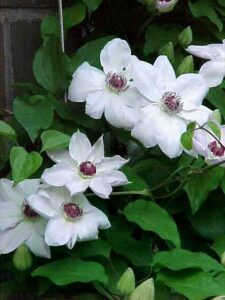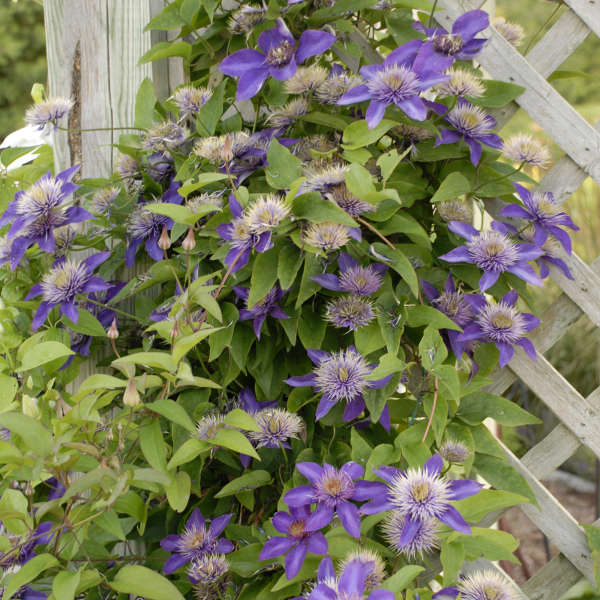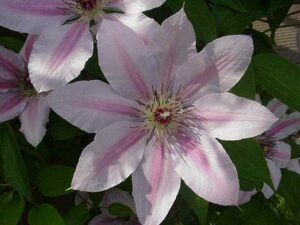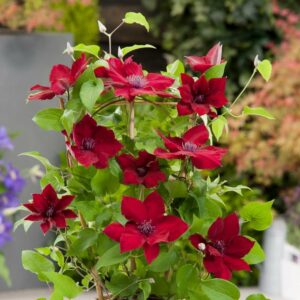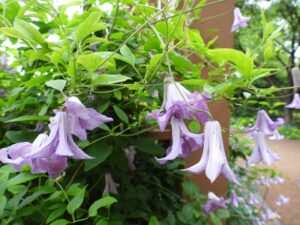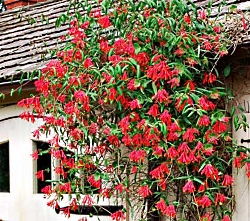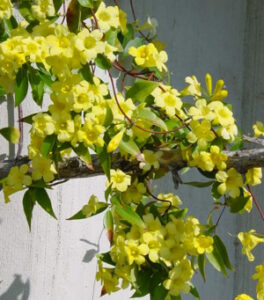Among the many beautiful plants at this year’s plant sale, we are offering these beautiful vines and climbers.
Clematis Henryi
‘Henryi’ features profuse, showy, eight-sepaled, 6-8″ in diameter, white flowers with purplish brown anthers that cover this vine in summer. Bloom on this cultivar comes primarily from the previous year’s stems in early summer, but also occurs in a second flush later in the summer on the new (current year’s) growth.
Clematis Multi Blue
Clematis ‘Multi Blue’ is a large flowering variety of clematis that is a sport of Clematis ‘The President’. The well-rounded 4-5 inch double flowers have deep purple-blue outer layer petals, topped with many layers of shorter, pointed, reddish-purple petals. Standing 5-10 feet tall, ‘Multi Blue’ blooms in May to June and again in August through October. Clematis ‘Multi Blue’ is a great rebloomer. ‘Multi Blue’ grows in full sun to part shade locations, although it prefers a part shade location.
Clematis Nelly Moser
‘Nelly Moser’ features profuse, showy, eight-sepaled, 6-8″ diameter, pale mauve pink flowers (sepals have reddish pink center stripes) with purplish brown anthers that cover this vine in summer. Bloom on this cultivar comes primarily from the previous year’s stems in late spring, but also occurs in a second flush later in the summer on the new (current year’s) growth. Flowers give way to attractive seed heads.
Clematis Nubia
Free-flowering and hardy, this exceptionally dark red, compact, reblooming clematis is excellent for large planters or as an entryway accent. Blooms prolifically from both leaf axils and stems, resulting in flowers from the ground up. An improvement over ‘Rebecca’. Deciduous.
Clematis Betty Corning
‘Betty Corning’ (C. crispa x C. viticella) is a late, small-flowered, semi-woody, climbing vine that was first discovered growing in Albany, New York in 1932. It typically grows to 6′ tall. It features single, nodding, bell-shaped, pale lilac flowers (to 2” long) with recurved tips. Flowers freely bloom from summer to fall. Flowers are slightly fragrant. Branches are clad with bipinnate to pinnate-compound dark green leaves.
Lonicera s. Major Wheeler
Hummingbird favorite: Lonicera sempervirens ‘Major Wheeler’ produces a blanket of tubular, reddish orange to coral flowers from late spring through summer. Later, the vines’ red berries attract goldfinches and robins. It’s a selection of our native Honeysuckle species, Lonicera sempervirens, and plants are both carefree and noninvasive. They bloom on the previous year’s growth as well as new growth. Regular pruning is not required—any pruning to shape the vine can be done once flowering is over for the season. Do provide a trellis, fence, or post with wire grid for support.
Gelsemium s. Margarita
Carolina jessamine. A reliable zone 6 Gelsemium! A profuse display of clear yellow trumpet flowers in early summer with semievergreen foliage. ‘Margarita’ is a superior seedling selected by Don Jacobs of Eco Gardens in Decatur, Georgia.With its much larger, more prominent flowers, it was superior in every way to common seedlings, so Jacobs named it for his wife. He had no idea that it would survive winters to minus 25 F. Gelsemium ‘Margarita’ is a Gold Medal Award winner from the Pennsylvania Horticultural Society.
Heather Emelander – Plant Sale Chair
